Hybrid Power System Design for Multifunctional Mini-Loader Vehicles
Abstract
:1. Introduction
2. Materials and Methods
2.1. Vehicle Mobile Module
2.2. Design of the Hybrid Power System
2.2.1. Design of the Drive Specifications
2.2.2. Motor/Generator
2.2.3. Battery Pack
2.3. Design of the Hydraulic System and Tool Modules
2.4. 3D Modeling of the Multifunctional Mini-Loader Vehicle
3. Results
3.1. Assembly of the Multifunctional Mini-Loader Vehicle
3.2. Hybrid Power System and Hydraulic Pump System Tests
3.3. Field Test
4. Discussion
- Longer operating time and better energy efficiency: The engine can operate at optimum conditions for a longer time, and can rest in the non-optimal operating range. Therefore, through the design of this study, the operation time and energy efficiency can be improved by using EM to provide power or starting battery charging mode to convert wasted power into electricity.
- Less air pollution: Air pollution can be reduced because the power system can adjust output torque in different operation conditions in a hybrid power mode. Avoiding inefficient engine operation can reduce carbon emissions caused by fuel combustion. With the help of hybrid powertrain design and the auxiliary output of generators and electric motors, the engine can run in the optimum efficiency range for a longer time, thus reducing air pollution and improving energy efficiency.
- Hydraulic pump performance: The electric hydraulic pump module successfully dumped the cargo into the cargo bed. During the dumping process, it is observed that when too close to the cargo, the operator is likely to inhale dust or be injured by small dumping. Therefore, the MB-3 hydraulic valve and the solenoid valve are modified to an electronic control mode, and a remote controller of the hydraulic valve is added for operators to use from 1 m away from the loading platform, improving the comfort and safety of personnel.
- Climbing ability: In the three power mode tests, the vehicle climbed 10% and 30% slopes. However, because the centers of gravity of the hybrid power system and the hydraulic system are closer to the user, when the slope angle is too large, the system may tilt upwards or slip downwards, and personnel may be injured. This problem can be overcome by two ideas. The first idea is changing the position of the center of gravity by moving forward the motor/generator and the battery module to the space above the electric hydraulic pump. The second idea is adding a parking brake to supply a moderate reverse force.
- Obstacle crossing ability: The test results demonstrate that the vehicle can cross a short step of 140 mm in height. However, because of the center of gravity of the hybrid power system being closer to the user, when the empty vehicle tracks halfway on the step, the track on the step is slightly dangling. Nevertheless, this does not cause a safety issue. The dangling phenomenon in the unloaded vehicle can be overcome that similar to discussion point 2. This idea not only reduces the overall height of the hybrid power module on the vehicle, but also improves the torque gap between clockwise and counterclockwise.
- Trench crossing ability: The loader crossed a 300 mm trench, but because the center of gravity is closer to the user, it should be noted that an unloaded vehicle may tilt upwards. The solution is the same as the second and third discussion points, which can be overcome by adjusting the center of gravity of the vehicle. This is conducive to overcoming the doubts of tilt upwards and slight dangling caused by climbing, and obstacle and trench crossing when the vehicle has no load.
- The current designed tools are suitable for excavation, soil transport, and soil loosening functions. In addition to meeting the requirements for agricultural farming, important functions required for disaster relief, such as grabbing and dozing tools, will also be considered in subsequent designs.
5. Conclusions
- This study designed a hybrid power system according to the functional requirements. This hybrid power multifunctional mini-loader has the advantages of small size, improved energy efficiency, and reduced air pollution and is more operator-friendly.
- This study conducted experiments on the engine mode, the hybrid power mode, and the motor mode. The results demonstrate that the power system can increase the operating time by more than 30 min by interactive switching of the three modes.
- This study illustrates from field tests that the loader platform can pass through 770 mm wide gates, cross 140 mm high short steps, cross 300 mm trenches, and climb 30% slopes.
- The task of designing the excavation and transportation tools has been accomplished in this study. The structure of the module allows quick disassembly, and it can be extended to plowing and pesticide spraying functions and crucial functions required for disaster relief, such as grabbing tools and dozing tools.
Author Contributions
Acknowledgments
Conflicts of Interest
References
- Truong, D.Q.; Marco, J.; Greenwood, D.; Harper, L.; Corrochano, D.G.; Yoon, J.I. Challenges of micro/mild hybridisation for construction machinery and applicability in UK. Renew. Sustain. Energy Rev. 2018, 91, 301–320. [Google Scholar] [CrossRef] [Green Version]
- Chen, P.T.; Pai, P.H.; Yang, C.J.; Huang, K.D. Development of transmission systems for parallel hybrid electric vehicles. Appl. Sci. 2019, 9, 1538. [Google Scholar] [CrossRef]
- Chen, P.T.; Shen, D.J.; Yang, C.J.; Huang, K.D. Development of a hybrid electric motorcycle that accords energy efficiency and controllability via inverse differential gear and power mode switching control. Appl. Sci. 2019, 9, 1787. [Google Scholar] [CrossRef]
- Quan, Z.; Quan, L.; Zhang, J. Review of energy efficient direct pump controlled cylinder electro-hydraulic technology. Renew. Sustain. Energy Rev. 2014, 35, 336–346. [Google Scholar] [CrossRef]
- Wang, T.; Wang, Q. Efficiency analysis and evaluation of energy-saving pressure-compensated circuit for hybrid hydraulic excavator. Autom. Constr. 2014, 47, 62–68. [Google Scholar] [CrossRef]
- Bedotti, A.; Campanini, F.; Pastori, M.; Ricco, L.; Casoli, P. Energy saving solutions for a hydraulic excavator. Energy Procedia 2017, 126, 1099–1106. [Google Scholar] [CrossRef]
- Xia, L.; Quan, L.; Ge, L.; Hao, Y. Energy efficiency analysis of integrated drive and energy recuperation system for hydraulic excavator boom. Energy Convers. Manag. 2018, 156, 680–687. [Google Scholar] [CrossRef]
- Gong, J.; Zhang, D.; Guo, Y.; Liu, C.; Zhao, Y.; Hu, P.; Quan, W. Power control strategy and performance evaluation of a novel electrohydraulic energy-saving system. Appl. Energy 2019, 233–234, 724–734. [Google Scholar] [CrossRef]
- Shen, W.; Jiang, J.; Su, X.; Karimi, H.R. Control strategy analysis of the hydraulic hybrid excavator. J. Frankl. Inst. 2015, 352, 541–561. [Google Scholar] [CrossRef]
- Chen, Q.; Lin, T.; Ren, H. Parameters optimization and control strategy of power train systems in hybrid hydraulic excavators. Mechatronics 2018, 56, 16–25. [Google Scholar] [CrossRef]
- Lin, T.; Wang, Q.; Hu, B.; Gong, W. Research on the energy regeneration systems for hybrid hydraulic excavators. Autom. Constr. 2010, 19, 1016–1026. [Google Scholar] [CrossRef]
- Wang, T.; Wang, Q.; Lin, T. Improvement of boom control performance for hybrid hydraulic excavator with potential energy recovery. Autom. Constr. 2013, 30, 161–169. [Google Scholar] [CrossRef]
- Hao, Y.; Quan, L.; Cheng, H.; Xia, L.; Ge, L.; Zhao, B. Potential energy directly conversion and utilization methods used for heavy duty lifting machinery. Energy 2018, 155, 242–251. [Google Scholar] [CrossRef]
- Ge, L.; Quan, L.; Li, Y.; Zhang, X.; Yang, J. A novel hydraulic excavator boom driving system with high efficiency and potential energy regeneration capability. Energy Convers. Manag. 2018, 166, 308–317. [Google Scholar] [CrossRef]
- Chen, Q.; Lin, T.; Ren, H.; Fu, S. Novel potential energy regeneration systems for hybrid hydraulic excavators. Math. Comput. Simul. 2019, 163, 130–145. [Google Scholar] [CrossRef]
- Lin, T.; Chen, Q.; Ren, H.; Huang, W.; Chen, Q.; Fu, S. Review of boom potential energy regeneration technology for hydraulic construction machinery. Renew. Sustain. Energy Rev. 2017, 79, 358–371. [Google Scholar] [CrossRef]
- Wang, H.; Wang, Q.; Hu, B. A review of developments in energy storage systems for hybrid excavators. Autom. Constr. 2017, 80, 1–10. [Google Scholar] [CrossRef]
- He, X.; Jiang, Y. Review of hybrid electric systems for construction machinery. Autom. Constr. 2018, 92, 286–296. [Google Scholar] [CrossRef]
- Lin, T.; Wang, Q.; Hu, B.; Gong, W. Development of hybrid powered hydraulic construction machinery. Autom. Constr. 2010, 19, 11–19. [Google Scholar] [CrossRef]
- Baldizzone, S. Performance and Fuel Economy Analysis of a Mild Hybrid Vehicle Equipped with Belt Starter Generator. Ph.D. Thesis, University of Windsor, Windsor, ON, Canada, 2012. [Google Scholar]
- Steffan, R.; Hofmann, P.; Geringer, B. Potentials of a 48 Volt Belt-Starter-Generator in the Powertrain of an Ultra-Light Vehicle. In Proceedings of the SAE 2015 World Congress, New York, NY, USA, 2015, 14 April 2015. Paper ID 2015-01-1155, Detroit. [Google Scholar]
- Chen, P.T.; Yang, F.H.; Gao, H.M.; Huang, K.D. Moderate energy for charging Li-ion batteries determined by first-principles calculations. Batter. Supercaps 2018, 1, 209–214. [Google Scholar] [CrossRef]
- Chen, P.T.; Yang, F.H.; Cao, Z.T.; Jhang, J.M.; Gao, H.M.; Yang, M.H.; Huang, K.D. Reviving aged Lithium-ion batteries and prolonging their cycle life by sinusoidal waveform charging strategy. Batter. Supercaps 2019, 2, 673–677. [Google Scholar] [CrossRef]
- Chen, J.; Lin, M.; Lu, T. Parameter Matching Analysis and Application of Electric Vehicle Power System. In Proceedings of the 15th National Conference on Vehicle Engineering, Tainan, Taiwan, 26 November 2010. [Google Scholar]
- Mitsubishi Heavy Industries Engine. Available online: http://www.mhiet.co.jp/en/ (accessed on 5 May 2019).
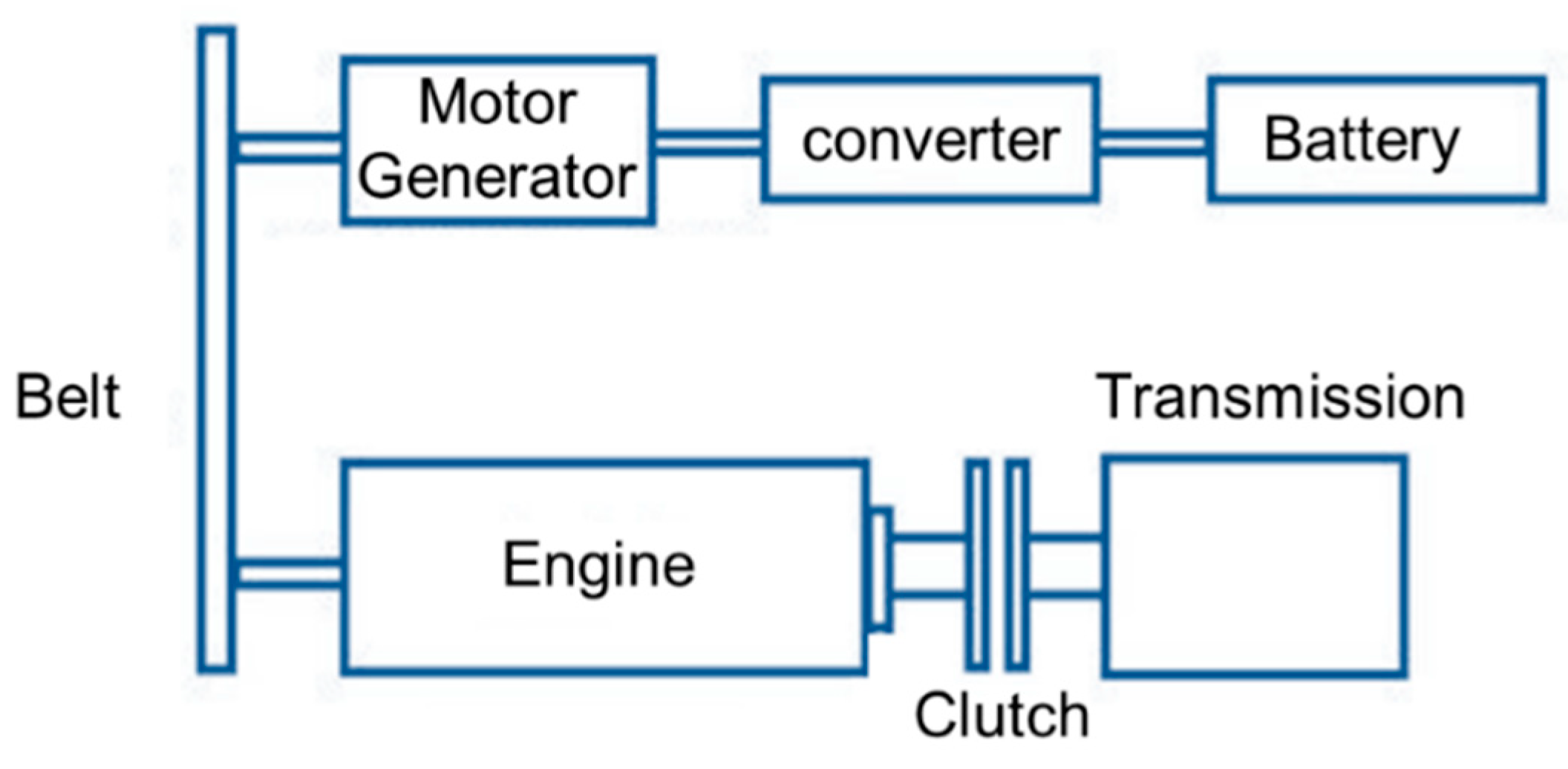
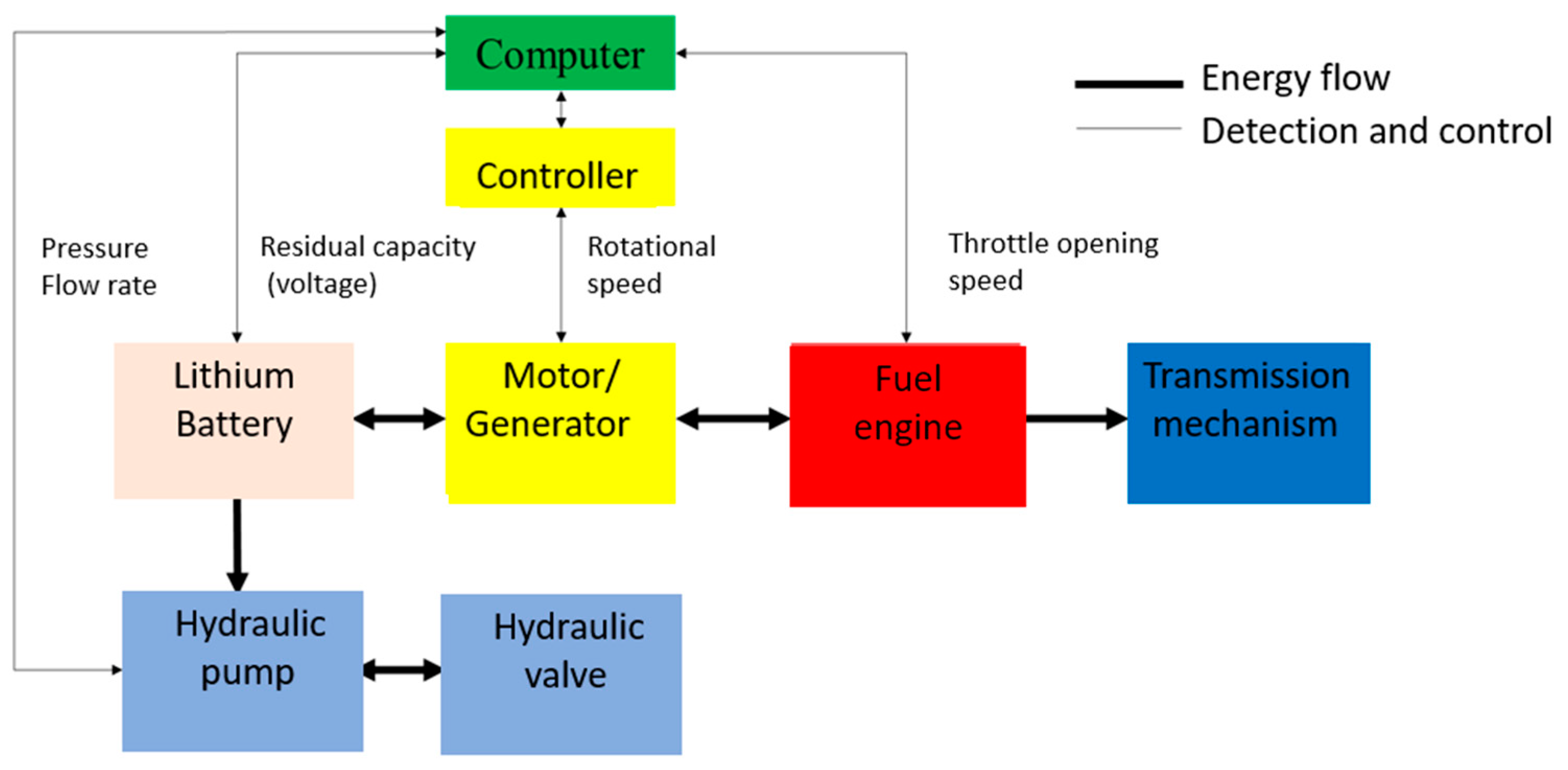
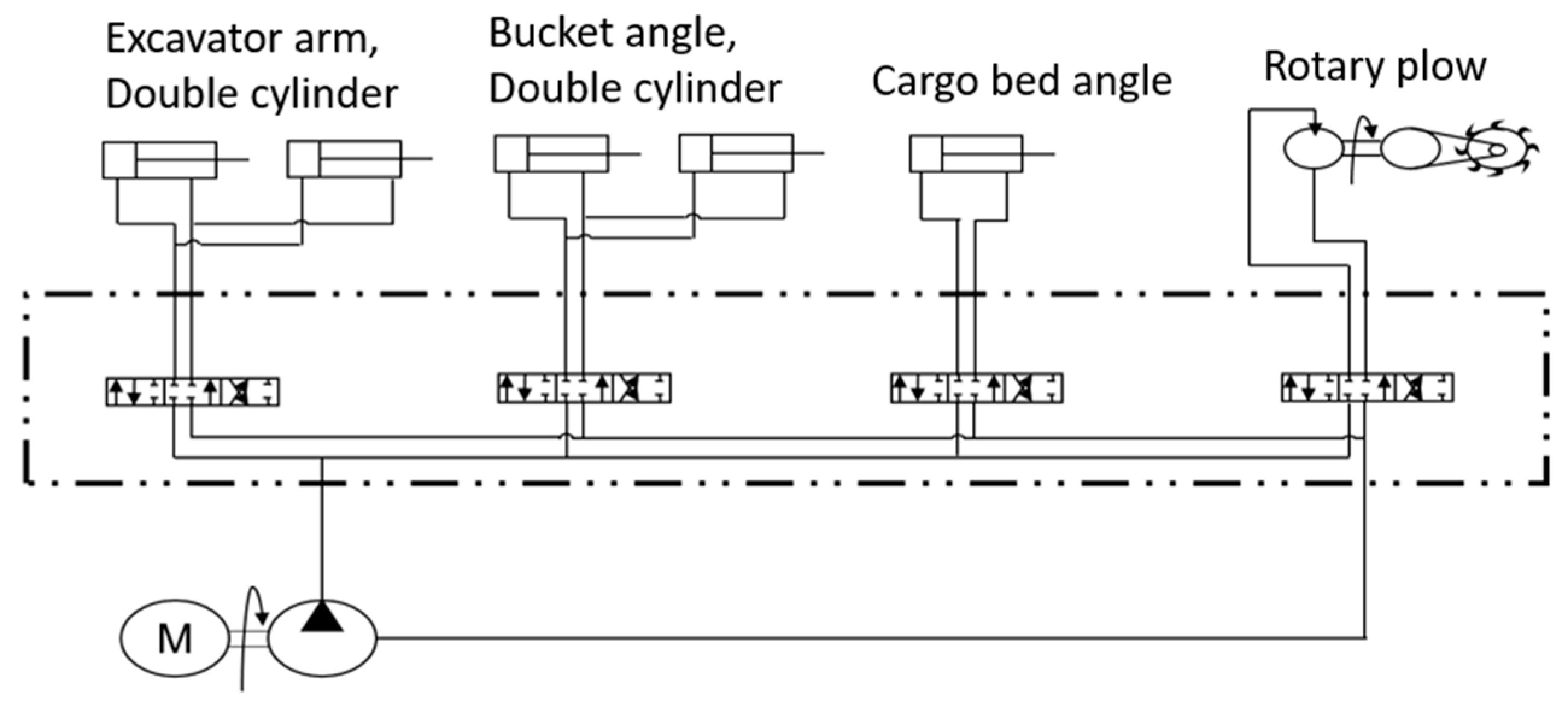
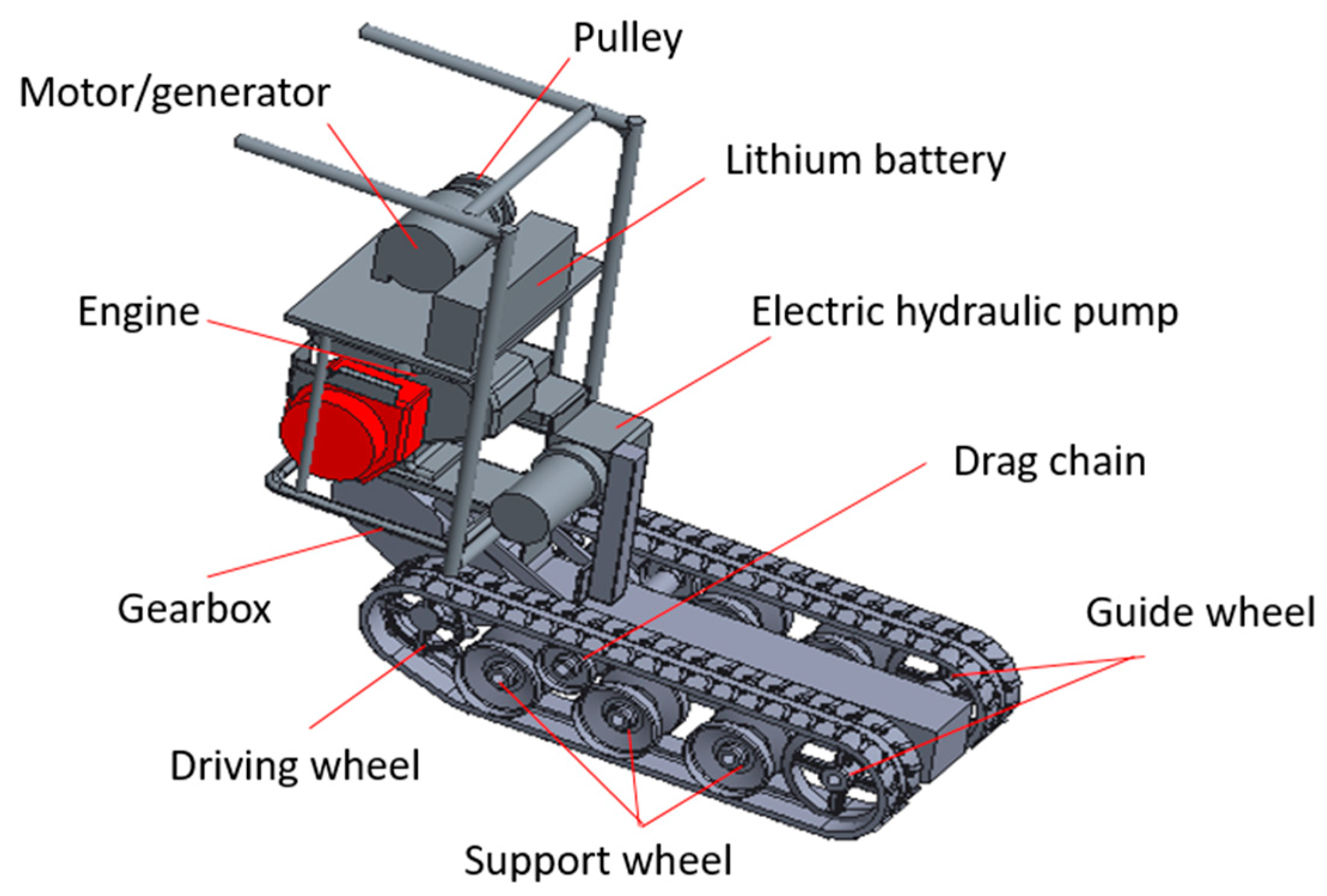
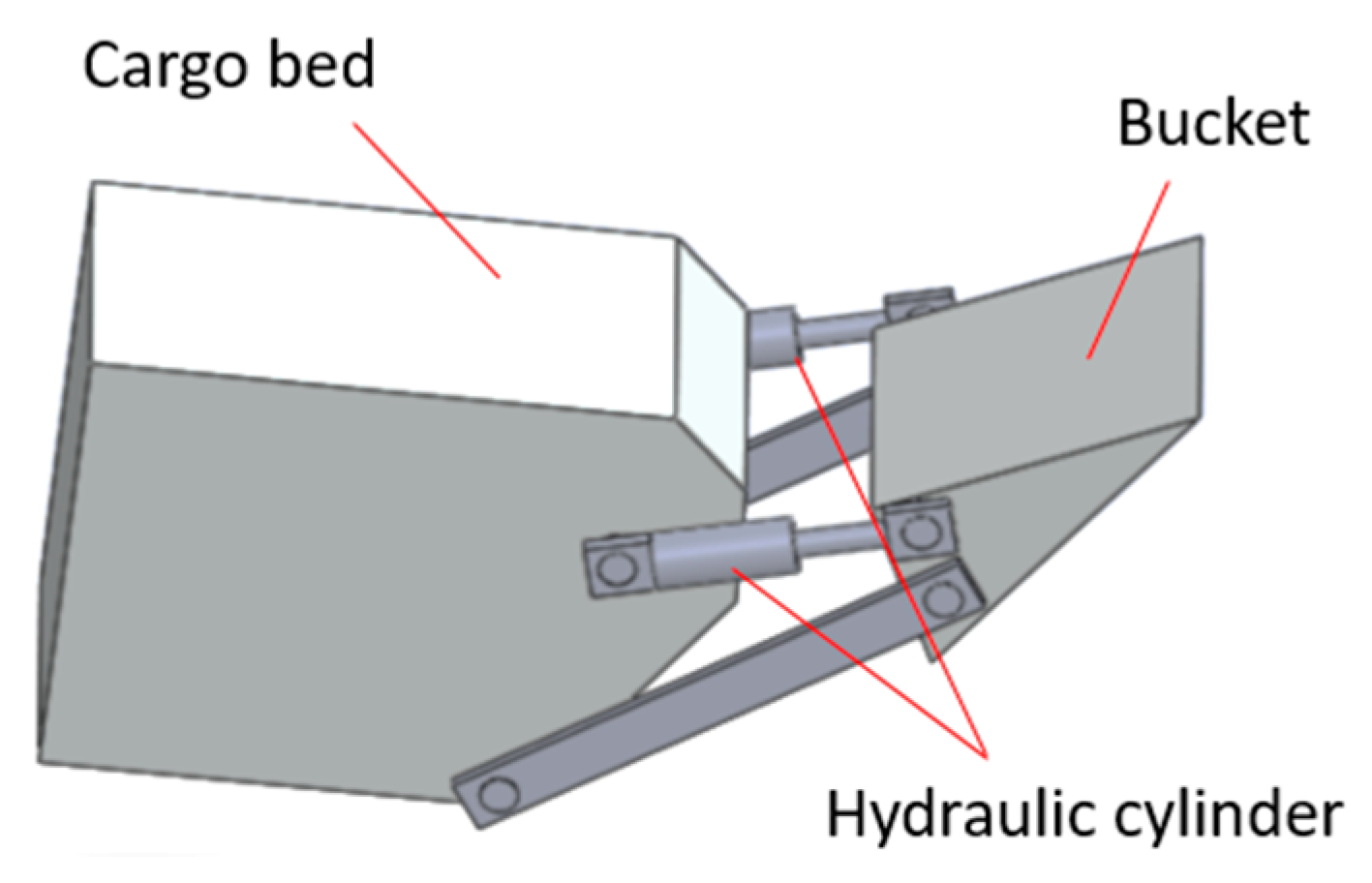
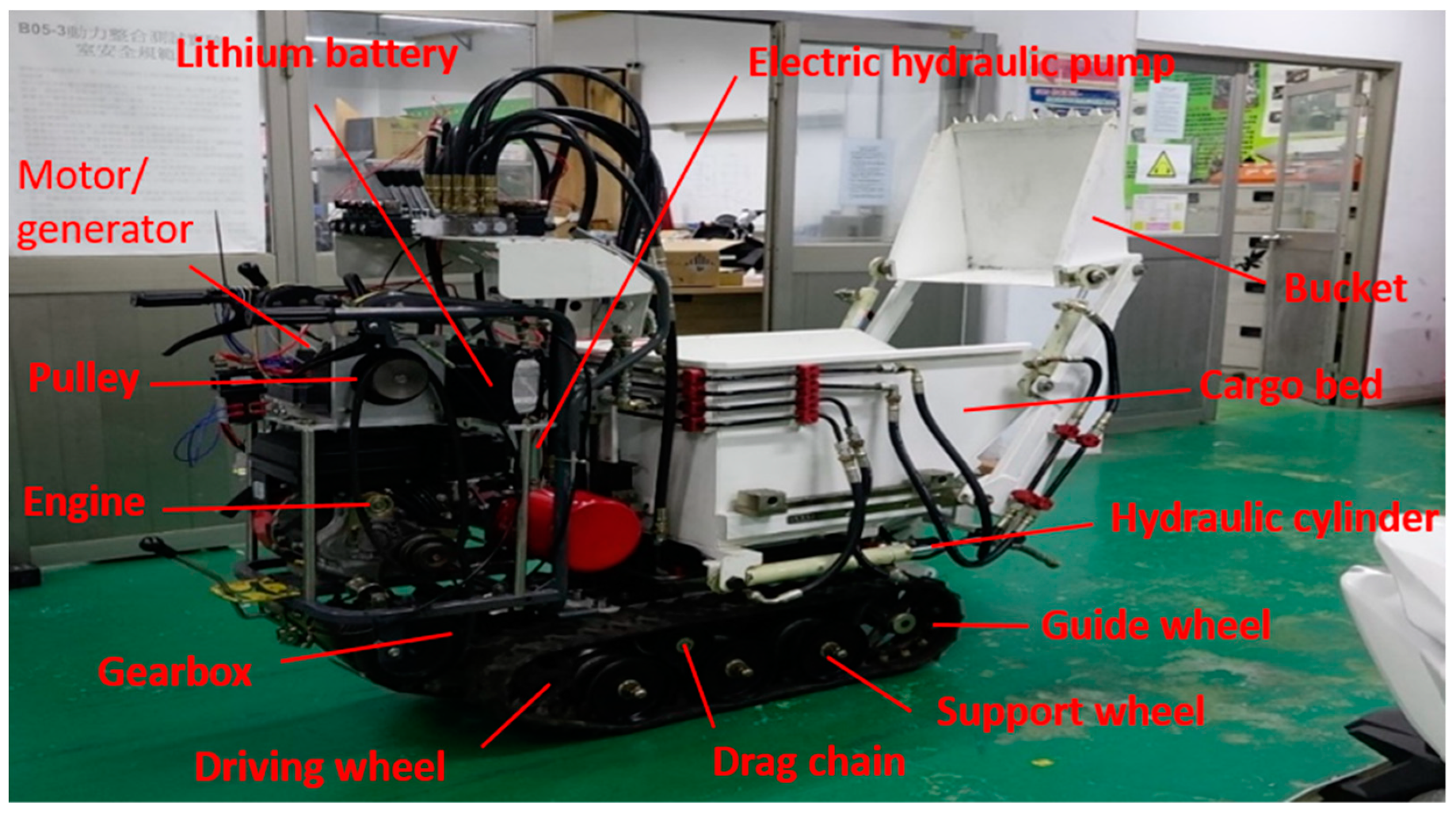
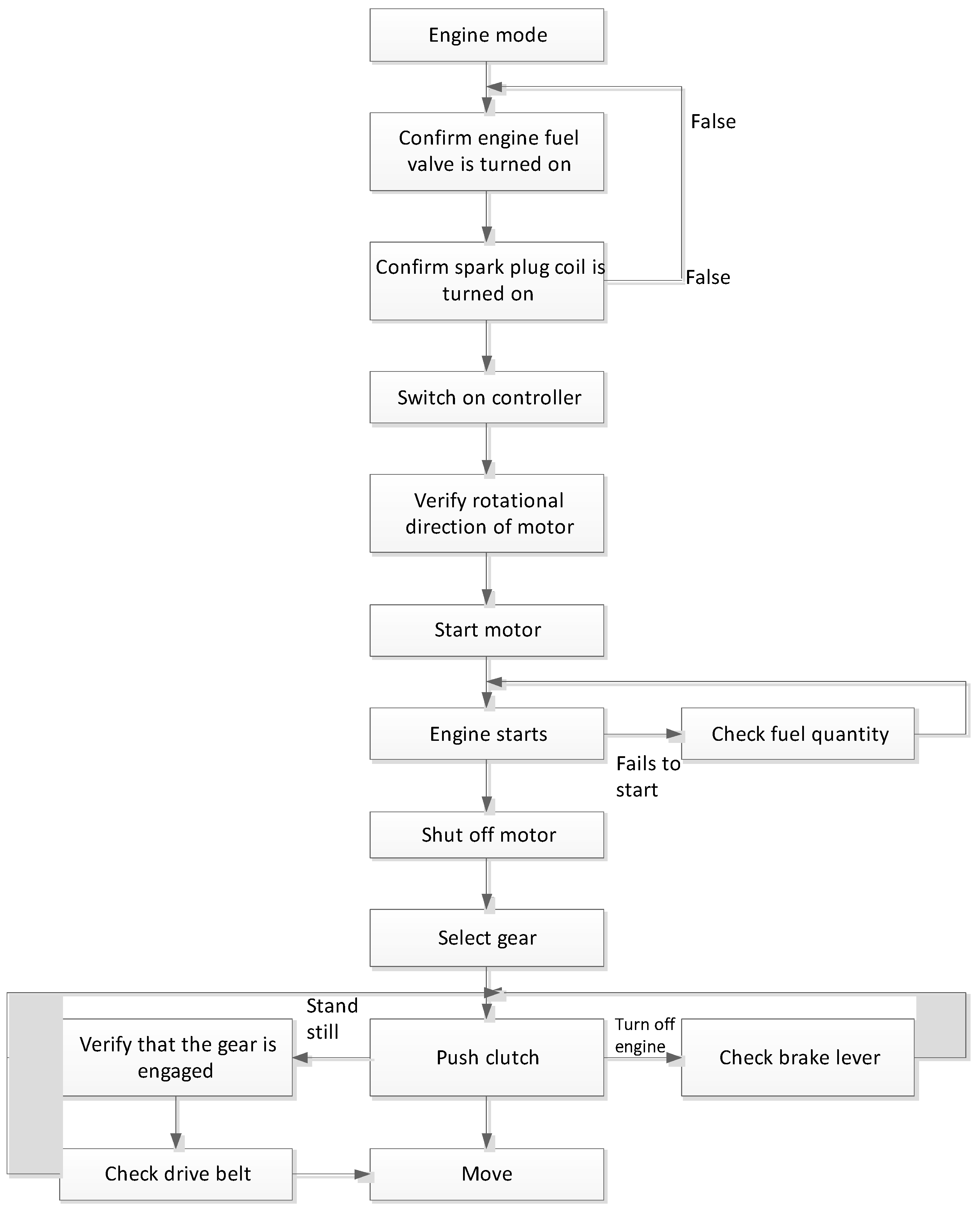


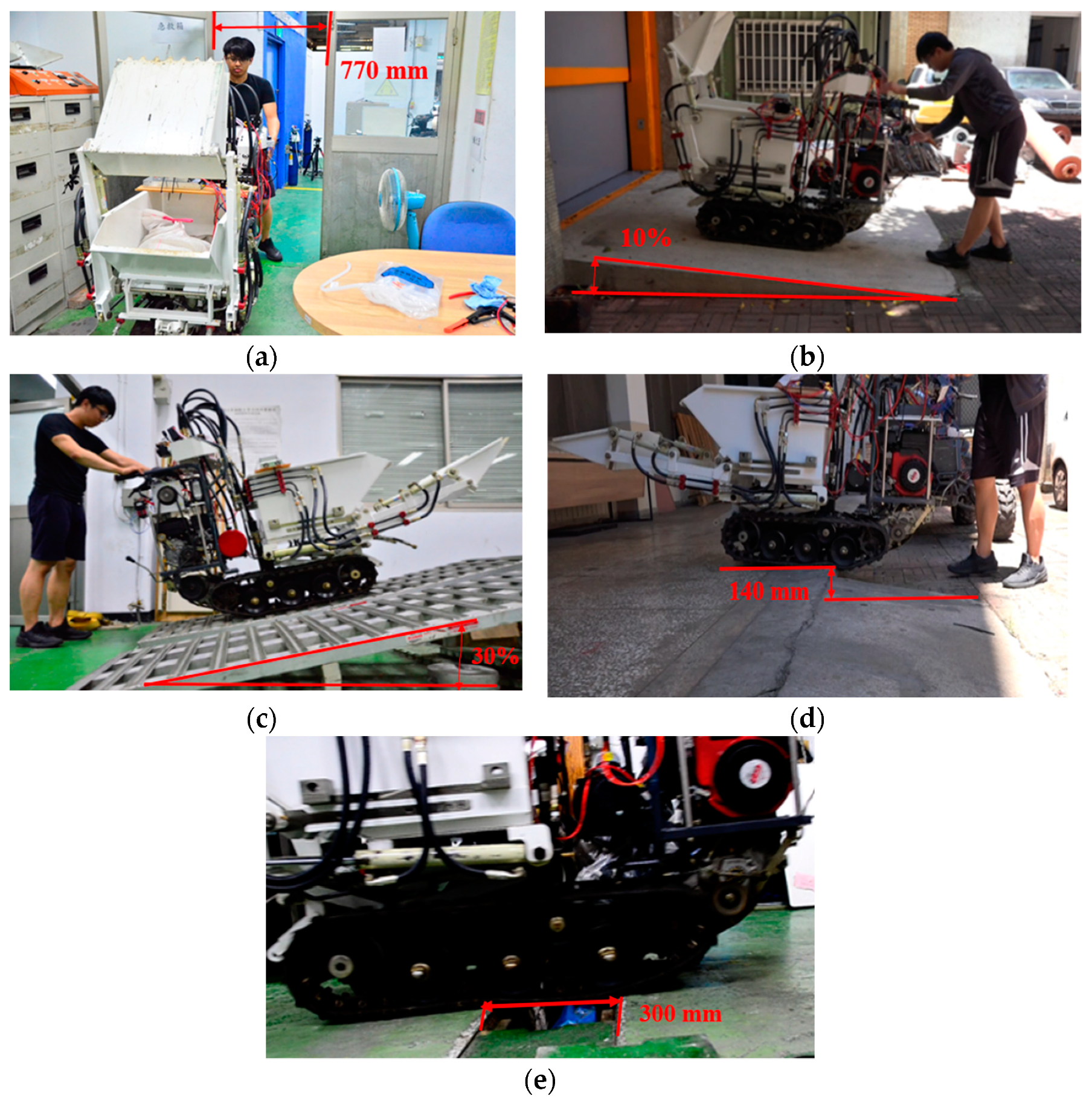
| Empty Weight of the Vehicle | 470 kg |
| Drive System Power | 3.5 kW |
| Maximum Load Capacity | 250 kg |
| Maximum Unloaded Speed on Normal Roads | |
| Maximum Fully Loaded Speed on Normal Roads | |
| Maximum Grade | |
| Maximum Speed at Maximum Grade |
| Item | Data |
|---|---|
| Motor Structure | Inner rotor |
| Motor Type | Permanent magnet synchronous motor |
| Voltage | 39 to 58 V |
| Cooling Method | Natural air cooling |
| Weight | 6.3 kg |
| Rated Output Power | 1.598 kW |
| Rated Rotational Speed | 3300 rpm |
| Rated Torque | 4.6 Nm |
| Maximum Output Power | 4.0 kW |
| Maximum Speed | 5380 rpm |
| Maximum Torque | 16.56 Nm |
| Battery Type | |
|---|---|
| Rated Voltage (V) | |
| Rated Capacity (mAh) | |
| Maximum Continuous Discharge Current (C/A) | |
| Maximum Impulse Discharge Current (C/A) | |
| Maximum Charging Voltage (V) | |
| Discharge Cutoff Voltage (V) | |
| Charging Current (C) | |
| Weight (g) | |
| Cycle Life (count) |
| Dimension | Length Width Height (mm) | 1700 700 1600 | ||
| Weight (kg) | 470 | |||
| FuelEngine | Name | Mitsubishi GB 180 [25] | ||
| Rated Output and Rotational Speed (kW/rpm) | 4.6/1800 | |||
| Fuel Type | Unleaded gasoline | |||
| Fuel Tank Capacity (L) | 3.6 | |||
| Ignition Mode | Motor ignition | |||
| MotorGenerator | Name | ADATA MC016 | ||
| Rated Output and Rotational Speed (kW/rpm) | 1.598/3300 | |||
| Maximum Output and Rotational Speed (kW/rpm) | 4.0/5380 | |||
| Motor Current (A) | 10 | |||
| Generator Current (A) | 5 | |||
| Battery | Name | A123 26650 | ||
| Rated Voltage (V) | 48 | |||
| Capacitance (Ah) | 12 | |||
| Power Transmission Mode | V-type power belt | |||
| Steering Device | Handle steering clutch | |||
| Transmission Clutch Type | Tension wheel | |||
| Number of Shifts | 2 | |||
| Braking Device | Drum brake | |||
| Forward Speed of Each Gear (km/h) | Forward Gear | Reverse Gear | ||
| Low Gear | 1.8 | 1.6 | ||
| High Gear | 3.6 | 3.3 | ||
| Rated Output (kW) | 2.0 |
| Operating Voltage (V) | 24 |
| Maximum Current (A) | 150 |
| Maximum Output (kW) | 2.5 |
| Working Pressure (bar) | 170 |
| System Displacement (cc/rev) | 2.6 |
© 2019 by the authors. Licensee MDPI, Basel, Switzerland. This article is an open access article distributed under the terms and conditions of the Creative Commons Attribution (CC BY) license (http://creativecommons.org/licenses/by/4.0/).
Share and Cite
Chen, P.-T.; Ding, P.-F.; Yang, C.-J.; Huang, K.D. Hybrid Power System Design for Multifunctional Mini-Loader Vehicles. Appl. Sci. 2019, 9, 4439. https://doi.org/10.3390/app9204439
Chen P-T, Ding P-F, Yang C-J, Huang KD. Hybrid Power System Design for Multifunctional Mini-Loader Vehicles. Applied Sciences. 2019; 9(20):4439. https://doi.org/10.3390/app9204439
Chicago/Turabian StyleChen, Po-Tuan, Pei-Fan Ding, Cheng-Jung Yang, and K. David Huang. 2019. "Hybrid Power System Design for Multifunctional Mini-Loader Vehicles" Applied Sciences 9, no. 20: 4439. https://doi.org/10.3390/app9204439
APA StyleChen, P.-T., Ding, P.-F., Yang, C.-J., & Huang, K. D. (2019). Hybrid Power System Design for Multifunctional Mini-Loader Vehicles. Applied Sciences, 9(20), 4439. https://doi.org/10.3390/app9204439





